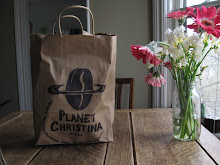On June 5th, 6th and 7th artists, environmentalists and festival participants gathered together at Studio 490 to make paper embedded with the native seeds we'd collected and to embroider onto the dried patches. The cozy feeling in the studio inspired many interesting conversations and connections, and made for some beautiful seed patches. Some chose to take their finished patches with them to plant in their gardens at home, while others chose to leave theirs as part of several community quilts to be planted.
Friday and Saturday saw three paper making workshops. Recycled scraps of paper were ripped up, blended with water in a kitchen blender (if you want to try this at home we recommend having a separate blender for paper as the sizer included in most papers is not edible) and mixed with seeds in a large bin. We had many different varieties of flower and grass seed paper mixes going, some whose seed fibres added unique texture and form to the paper. The pulp was then sifted onto homemade box screens, drained and placed on cloth to dry. Caleb Couch, our youngest participant (4 years) , turned out to be an exceptional paper maker and made many many amazing patches. The sun came out on Saturday afternoon and we set the paper out to dry on the pavement outside the studio.
On Saturday and Sunday, we ran three embroidery workshops. Time and care were taken as the dry patches of paper were embroidered with images of blossoming flowers and grasses. One of the participants was quite perplexed as to why we were embroidering something that would soon go into the ground. This stimulated what I found to be an interesting conversation around art-making, questioning motivation and product/process based art. I myself have been exploring the idea of living processes of art. I like to make things that continually change and grow in unexpected ways, or sometimes disappear to the human eye. I think the idea of making something for what might appear to be nothing is interesting. I often participate in actions that seem futile, perhaps as a response to something bigger that I can't affect directly, or as a way of engaging in what I don't yet understand. There is also this idea of putting care and effort directly into the earth as a different ethic than much of modern living embodies. Hmm... Alongside these conversations, some beautiful creations were made. I enjoyed the process of stitching the patches with others and the intersecting themes of ecology, community and art-making in the conversations that ebbed and flowed through the workshops.
A few days later, Louisa and I planted several of the patches just outside the studio, and I hope their roots will stretch and grow. It was a bit of a risky site as the doggy day care often take their dogs there to pee and they might unearth the seeds, but we will see...
Thanks to everyone who attended and contributed to the workshop, I hope a few seeds were sown and I look forward to seeing them blossom in time.
Wednesday, November 11, 2009
WAKE UP TIME - Stratification
Most sleepy sleepy seeds who spend all winter in a warm cozy paper bag need a little tap on the shoulder or a fresh cold shower to wake them up to get ready to grow. Colin and I spent a couple hours in May sorting seeds, giving them a bath and placing them in containers with cool water where they will sit and chill in the fridge for several weeks until germination time.
This is called stratification and it mimics the natural conditions a plant expects from its native environment. Seeds that are shed in the late autumn expect a cool moist environment like the frosts and snows that cover our northern lands. Those who drop in the early fall or spring need a warm moist treatment to induce germination. Since we collected most of our seeds in the late fall, we give them a cool winter in their plastic containers in Colin's fridge. They sit next to the maple syrup from the market which surely gives them warm fuzzy thoughts about late winter and spring in Ontario.
Seeds are usually stratified for 4-6 weeks, but since we need them a bit sooner than that we'll give them a nice short winter season- only a few weeks in the cold. Hopefully it's enough to rouse them!
This is called stratification and it mimics the natural conditions a plant expects from its native environment. Seeds that are shed in the late autumn expect a cool moist environment like the frosts and snows that cover our northern lands. Those who drop in the early fall or spring need a warm moist treatment to induce germination. Since we collected most of our seeds in the late fall, we give them a cool winter in their plastic containers in Colin's fridge. They sit next to the maple syrup from the market which surely gives them warm fuzzy thoughts about late winter and spring in Ontario.
Seeds are usually stratified for 4-6 weeks, but since we need them a bit sooner than that we'll give them a nice short winter season- only a few weeks in the cold. Hopefully it's enough to rouse them!
Subscribe to:
Posts (Atom)















